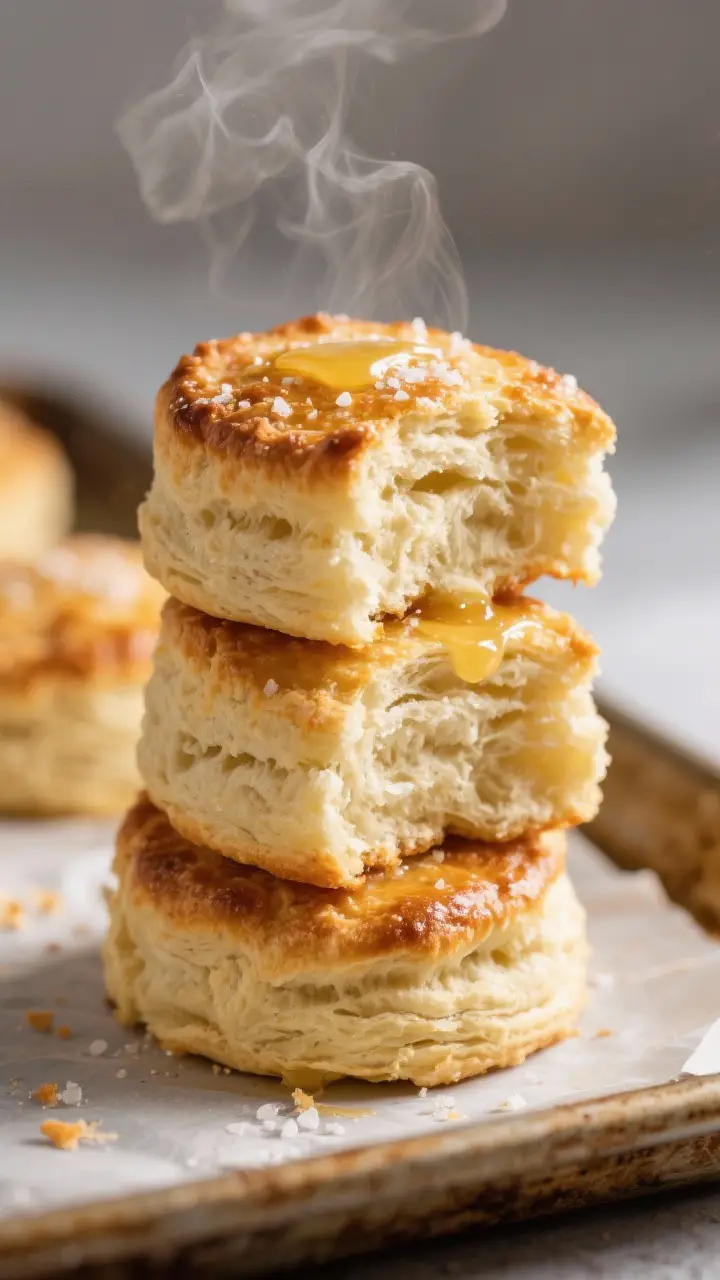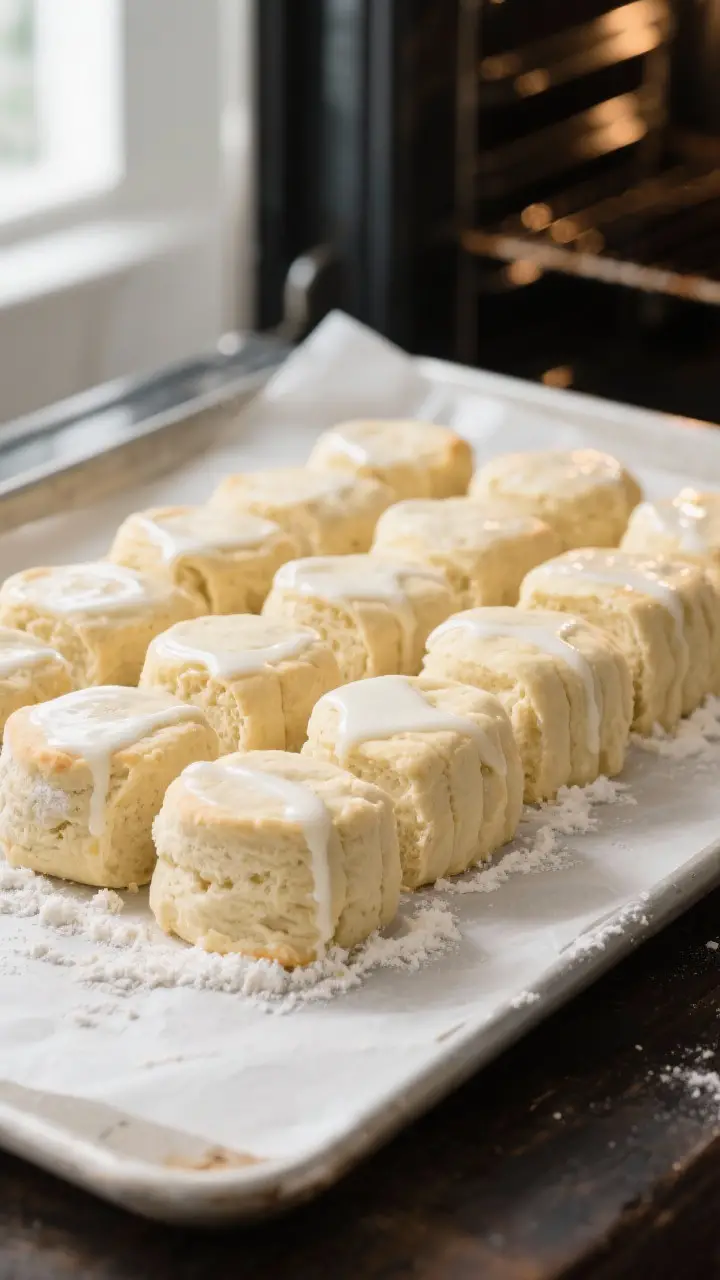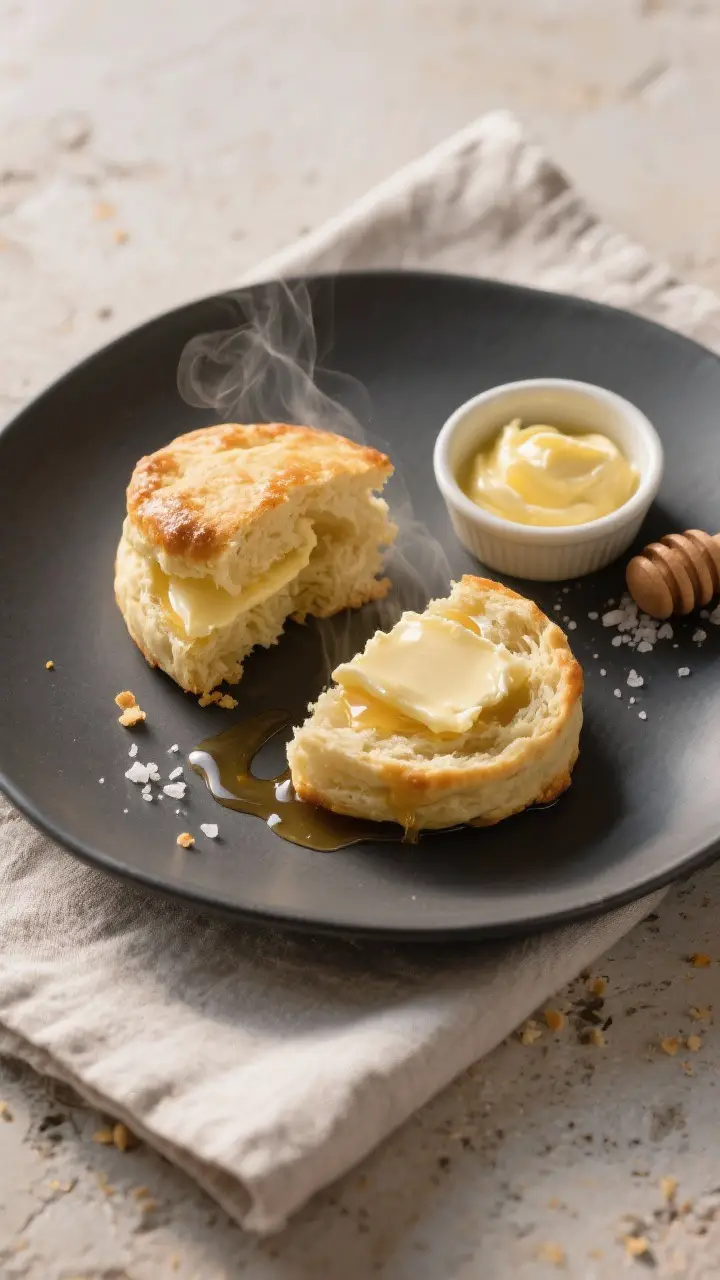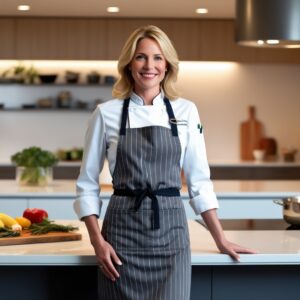You want buttery layers you can peel like a paperback? Good. Because most biscuits are either hockey pucks or grease bombs—and that’s a crime.
The trick isn’t magic; it’s science with a side of discipline. Cold fat, confident handling, and a hot oven do the heavy lifting. Follow this, and you’ll have biscuits that make brunch guests think you have a Southern grandma on retainer.
What Makes This Special

These buttermilk biscuits are built for loft and layers.
We use a strategic fat blend, just enough sugar, and a folding technique that mimics laminated dough—without the drama. The result? A tender crumb inside with crispy, craggy tops that catch butter like a savings account catches interest.
Buttermilk pulls double duty: its acidity reacts with baking soda for lift and tenderizes gluten so the interior stays pillowy.
A high oven temp sets the steam quickly, locking in height. And yes, we cut them tall on purpose—because low-rise biscuits are a lifestyle we’re not living.
Ingredients
- 2 1/2 cups (300 g) all-purpose flour, plus extra for dusting
- 1 tablespoon baking powder
- 1/2 teaspoon baking soda
- 1 teaspoon fine sea salt
- 1 tablespoon granulated sugar (optional but recommended)
- 6 tablespoons (85 g) cold unsalted butter, cut into 1/2-inch cubes
- 2 tablespoons (25 g) cold shortening or additional butter (for extra tenderness)
- 3/4 to 1 cup (180–240 ml) cold buttermilk, plus extra for brushing
- Optional: Melted butter for brushing after baking; flaky salt for topping
How to Make It – Instructions

- Chill everything. Pop your butter cubes, shortening, and even your flour mix in the fridge for 10–15 minutes. Cold fat equals steam pockets, aka layers.
- Preheat hot. Set oven to 450°F (232°C).Line a sheet pan with parchment. High heat sets structure fast, so your biscuits rise before they spread.
- Mix the dry. In a large bowl, whisk flour, baking powder, baking soda, salt, and sugar until well combined. No clumps allowed.
- Cut in the fat. Add butter and shortening.Use a pastry cutter or fingertips to work fat into pea-sized pieces with a few larger, nickel-sized bits. Those bigger chunks equal flaky pockets—don’t overdo it.
- Add buttermilk. Pour in 3/4 cup buttermilk and stir with a fork until shaggy. If there are dry patches, add more buttermilk a tablespoon at a time.Dough should be slightly sticky but not wet.
- Turn out and quick-shape. Dust the counter lightly, dump the dough, and gently press into a rough rectangle. No kneading. You’re not making bread, you’re making clouds.
- Laminate-lite. Pat into a 1-inch-thick rectangle.Fold like a letter (in thirds). Rotate 90 degrees. Repeat this pat-and-fold 3 times.This creates layers without fuss.
- Final thickness. Pat to a 1-inch slab. Taller dough = taller biscuits. Don’t roll thin unless you like regret.
- Cut clean. Use a 2.5-inch round cutter.Dip in flour, press straight down—no twisting. Twisting seals edges and blocks rise. Gather scraps gently and re-cut once.
- Arrange for crowd support. Place biscuits so they’re just touching on the pan.Snuggling helps them climb higher, like motivational speaking but for dough.
- Brush tops. Lightly brush with buttermilk for color. Avoid the sides (keeps layers from sealing).
- Bake. Bake 12–15 minutes until tall and golden-brown. Internal temp around 200°F (93°C) if you’re picky.
- Finish. Brush hot tops with melted butter and a tiny pinch of flaky salt.Let rest 5 minutes. Try not to inhale them all at once.
Storage Tips
- Room temp: Keep in an airtight container up to 2 days. Rewarm at 350°F (175°C) for 5–7 minutes.
- Freeze baked: Cool completely, wrap individually, freeze up to 2 months.Reheat from frozen at 350°F for 10–12 minutes.
- Freeze unbaked: Cut biscuits, freeze on a sheet until firm, then bag. Bake from frozen at 450°F; add 2–4 minutes to the time.
- Revive stales: Split and toast under broiler with butter. Not a miracle, but close.

Health Benefits
We’re not calling biscuits a superfood, but there are a few wins.
A homemade version lets you control ingredients and portion size—no mystery oils or preservatives. Buttermilk brings a hit of calcium and adds flavor without extra fat.
Using real butter means satiety and flavor density, which can help you eat one great biscuit instead of three mediocre ones (IMO, quality beats quantity). Pair with protein—eggs, yogurt, smoked salmon—to make a more balanced meal.
Pitfalls to Watch Out For
- Warm fat = flat biscuits. Keep ingredients cold and work quickly.
- Overmixing = tough texture. Stop as soon as the dough comes together.Shaggy is good.
- Twisting the cutter. This seals edges and kills rise. Straight down, straight up.
- Too thin. Less than 1 inch before baking equals sadness after baking.
- Wrong oven temp. Low heat lets butter leak before structure sets. Stick to 450°F.
- Flour avalanche. Excess bench flour dries the dough.Dust lightly.
Alternatives
- No buttermilk? Use 1 cup milk minus 1 tablespoon, plus 1 tablespoon lemon juice or vinegar. Let sit 5 minutes. Or use kefir or thinned yogurt.
- Whole wheat twist: Swap 25–30% of flour for whole wheat.Add an extra tablespoon of buttermilk if dry.
- Cheddar-jalapeño: Fold in 3/4 cup sharp cheddar and 1–2 tablespoons minced jalapeño. Add a pinch of paprika.
- Herb + black pepper: Mix 1 tablespoon chopped chives or dill and 1/2 teaspoon cracked pepper into the dry ingredients.
- Dairy-free: Use plant-based butter and nondairy “buttermilk” (oat milk + lemon juice). Texture is slightly different but still solid.
- Gluten-free: Use a 1:1 gluten-free flour blend with xanthan gum; dough will be softer, so chill before cutting.

Perfect Buttermilk Biscuits
Equipment
- Pastry Cutter
- Biscuit Cutter
- Mixing Bowl
- Baking Sheet
- Parchment Paper
Ingredients
Dry Ingredients
- 2 1/2 cups all-purpose flour plus extra for dusting
- 1 tbsp baking powder
- 1/2 tsp baking soda
- 1 tsp fine sea salt
- 1 tbsp granulated sugar optional but recommended
Fat & Liquid
- 6 tbsp unsalted butter cold, cut into 1/2-inch cubes
- 2 tbsp shortening or extra butter cold, for tenderness
- 3/4 to 1 cup buttermilk cold, plus more for brushing
Optional Finishes
- melted butter for brushing after baking
- flaky salt for topping
Instructions
- Chill your flour, butter, and shortening for 10–15 minutes. Preheat oven to 450°F (232°C) and line a baking sheet with parchment.
- Whisk together flour, baking powder, baking soda, salt, and sugar until combined.
- Cut in butter and shortening using a pastry cutter or fingertips until pea-sized and a few nickel-sized bits remain.
- Add 3/4 cup buttermilk and stir just until shaggy. Add more buttermilk if dry.
- Turn dough onto a floured surface and gently press into a rectangle. Fold like a letter, rotate, and repeat 3 times.
- Pat dough into a 1-inch slab and cut using a 2.5-inch round cutter, pressing straight down without twisting.
- Place biscuits on the sheet so they touch. Brush tops with buttermilk and bake 12–15 minutes until golden.
- Brush hot biscuits with melted butter and sprinkle with flaky salt. Let rest 5 minutes before serving.
Notes
Nutrition
FAQ
Why didn’t my biscuits rise?
Likely culprits: warm fat, overworked dough, or twisting the cutter.
Also check your baking powder’s freshness—if it’s older than 6 months, it might be sleepy. Keep the dough 1 inch thick and bake hot.
Can I grate frozen butter instead of cubing?
Yes, and it’s a power move. Grated butter distributes fast and stays cold.
Work lightly so you don’t melt it with your hands.
What if I only have self-rising flour?
Use 2 1/2 cups self-rising flour and omit the baking powder and salt. Keep the baking soda at 1/2 teaspoon if using buttermilk for that acid-base boost.
How do I get extra-crispy tops?
Brush with buttermilk before baking and finish with melted butter after. For maximum crunch, bake on a preheated cast-iron skillet.
Sounds dramatic, works beautifully.
Can I make them ahead for a crowd?
Yes—cut and freeze unbaked biscuits. Bake from frozen right before serving. This keeps them fresh and saves you from 6 a.m. kitchen chaos, FYI.
What’s the best fat: butter or shortening?
Butter gives flavor and flaky layers; shortening boosts tenderness and height.
A combo nails both. If you’re butter-only, add an extra tablespoon to keep richness high.
Do I need a biscuit cutter?
Nope. A sharp knife or bench scraper works—just cut squares.
Bonus: no re-rolling scraps, and you still get tall stacks.
The Bottom Line
Perfect buttermilk biscuits aren’t a mystery—they’re a system. Keep the fat cold, the oven hot, and your hands gentle. Fold for layers, cut clean, and bake tall.
The payoff is buttery, cloud-light biscuits with crisp edges and serious height. Once you master these, store-bought will feel like a prank.












